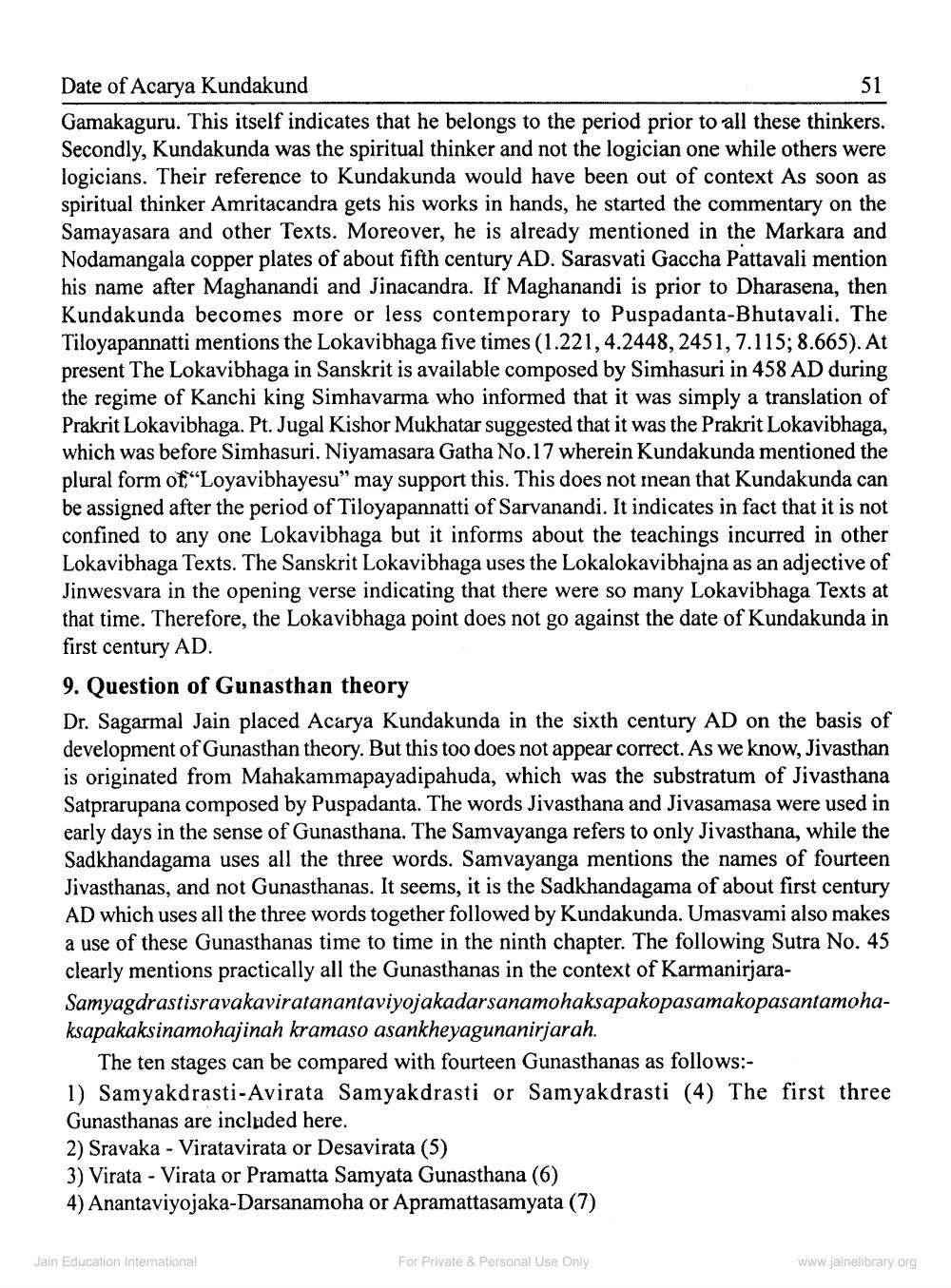________________
Date of Acarya Kundakund
51 Gamakaguru. This itself indicates that he belongs to the period prior to all these thinkers. Secondly, Kundakunda was the spiritual thinker and not the logician one while others were logicians. Their reference to Kundakunda would have been out of context As soon as spiritual thinker Amritacandra gets his works in hands, he started the commentary on the Samayasara and other Texts. Moreover, he is already mentioned in the Markara and Nodamangala copper plates of about fifth century AD. Sarasvati Gaccha Pattavali mention his name after Maghanandi and Jinacandra. If Maghanandi is prior to Dharasena, then Kundakunda becomes more or less contemporary to Puspadanta-Bhutavali. The Tiloyapannatti mentions the Lokavibhaga five times (1.221, 4.2448, 2451, 7.115; 8.665). At present The Lokavibhaga in Sanskrit is available composed by Simhasuri in 458 AD during the regime of Kanchi king Simhavarma who informed that it was simply a translation of Prakrit Lokavibhaga. Pt. Jugal Kishor Mukhatar suggested that it was the Prakrit Lokavibhaga, which was before Simhasuri. Niyamasara Gatha No.17 wherein Kundakunda mentioned the plural form of Loyavibhayesu" may support this. This does not inean that Kundakunda can be assigned after the period of Tiloyapannatti of Sarvanandi. It indicates in fact that it is not confined to any one Lokavibhaga but it informs about the teachings incurred in other Lokavibhaga Texts. The Sanskrit Lokavibhaga uses the Lokalokavibhajna as an adjective of Jinwesvara in the opening verse indicating that there were so many Lokavibhaga Texts at that time. Therefore, the Lokavibhaga point does not go against the date of Kundakunda in first century AD. 9. Question of Gunasthan theory Dr. Sagarmal Jain placed Acarya Kundakunda in the sixth century AD on the basis of development of Gunasthan theory. But this too does not appear correct. As we know, Jivasthan is originated from Mahakammapayadipahuda, which was the substratum of Jivasthana Satprarupana composed by Puspadanta. The words Jivasthana and Jivasamasa were used in early days in the sense of Gunasthana. The Samvayanga refers to only Jivasthana, while the Sadkhandagama uses all the three words. Samvayanga mentions the names of fourteen Jivasthanas, and not Gunasthanas. It seems, it is the Sadkhandagama of about first century AD which uses all the three words together followed by Kundakunda. Umasvami also makes a use of these Gunasthanas time to time in the ninth chapter. The following Sutra No. 45 clearly mentions practically all the Gunasthanas in the context of KarmanirjaraSamyagdrastisravakaviratanantaviyojakadarsanamohaksapakopasamakopasantamohaksapakaksinamohajinah kramaso asankheyagunanirjarah.
The ten stages can be compared with fourteen Gunasthanas as follows:1) Samyakdrasti-Avirata Samyak drasti or Samyak drasti (4) The first three Gunasthanas are included here. 2) Sravaka - Viratavirata or Desavirata (5) 3) Virata - Virata or Pramatta Samyata Gunasthana (6) 4) Anantaviyojaka-Darsanamoha or Apramattasamyata (7)
Jain Education International
For Private & Personal Use Only
www.jainelibrary.org




